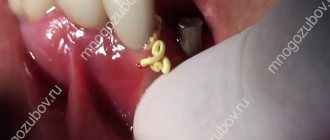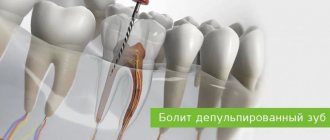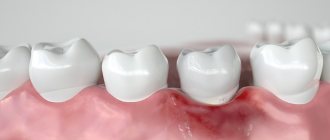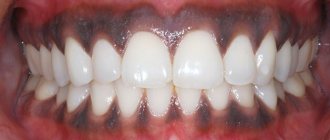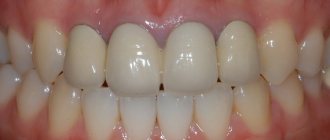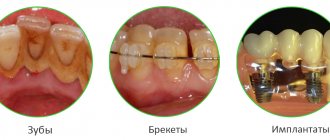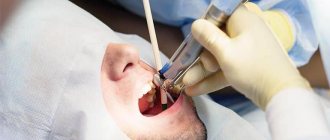Publication date: 01/26/2021
It’s a long wait for the artificial root to engraft, then for the formation of a gum ridge and get a beautiful smile in six months. And this is only if it was not necessary to additionally build up bone tissue. Otherwise, the treatment will take twice as long. The prospect is not very bright, you will agree. At the Ilatan Clinic, implant installation is carried out immediately after tooth extraction. This is a reliable method that allows you to minimize interference in the dental system and quickly restore the missing unit. Often, the implant can be immediately loaded with a crown - the patient will immediately receive a new tooth.
When can an implant be installed immediately after tooth extraction?
Indications for emergency implantation are:
- The presence of mobile, damaged teeth and roots that need to be removed;
- single, multiple restorations;
- tooth injury, with the inability to save it;
- fracture, crack of a tooth root;
- perforation of the dental canal during filling.
But installing an implant after tooth extraction is not always possible.
The doctor plans the procedure in advance, and a comprehensive diagnosis is required to assess the possibility of a one-time installation. In case of emergency removal without the necessary examination, the method is not used. In addition, the patient should not have contraindications to implantation and surgical interventions in general.
Good quality and sufficient volume of bone is important. If there is inflammation, a cyst, or any other pathological focus on the root of the extracted tooth, immediate implantation is not performed. Also, the procedure will have to be postponed if the removal was traumatic or the alveolar process was severely damaged.
Similar methods and alternative solutions
One-stage implantation with immediate loading
The essence of the method is to use implants of a special design and shape, which are loaded with a denture on the day of installation or after 2-3 days. The use of this treatment protocol is more recommended in the absence of 3 or more teeth, since in this case at least 3 implants are installed, the position of which is stabilized by the installed prosthesis. This allows them to be securely fixed and not move under load. After tooth extraction, it is not necessary to wait for complete rehabilitation of the bone - implants (subject to availability of space, that is, with complete or almost complete edentia) can be installed in the holes nearby.
Read more about one-stage implantation >>>
Implantation with delayed loading
Classical implantation, which is recommended for single and isolated dentition defects. Two-piece implants are used, which can be loaded with a permanent prosthesis only after their complete osseointegration into the bone tissue, that is, after at least 2-4 months. This method allows you to achieve high aesthetic values due to the formation of the gingival contour. But after a tooth is removed, a certain amount of time must pass during which the bone tissue will recover.
Read more about classical implantation >>>
Simultaneous implantation is carried out according to strict indications. However, this is the best option when you need to remove teeth and quickly replace them with implants. Patients should remember that after removal of the roots, the bone tissue is absorbed within several months and noticeably decreases in volume (in the first year - by an average of 25%2); subsequently, before implantation, bone grafting will be required - and this involves both time and material costs. spending. Therefore, you should not delay the restoration of lost teeth.
1 Kotenko M.V. Effectiveness of immediate implantation with different types of implants. Siberian Medical Journal, 2011. 2 Sokov L.P. Guide to neuroorthopedics. M.: RUDN, 2002.
Advantages of one-stage implantation
The following advantages are associated with installing an implant after tooth extraction:
- Reducing treatment time;
- minimal trauma - no re-operation or formation of a bed for the implant is required in the bone;
- no need for bone grafting;
- preservation of the natural gum contour;
- the ability to immediately load the titanium root with a prosthesis.
If there are all conditions for immediate implantation, this opportunity should be used. The advantages of the technique of installing an implant in the socket of an extracted tooth are especially relevant in the smile area. The implant is immediately implanted without surgery - the tooth is removed from the socket, and a titanium root is screwed in its place. More often, immediately covering it with a prosthesis.
Immediate dental implantation and its benefits
Ensuring a beautiful appearance, especially in the frontal area, is no less important than restoring the functions of speech and chewing, and the already mentioned “pink aesthetics,” that is, a neat contour of the gums, is no less important than the correctly selected color and shape of an artificial tooth. The advantage of one-stage jaw implantation is that, regardless of whether we load the implant with a temporary crown or install a gum former, we maintain the original contour of the soft tissues. In the case of two-stage implantation, this circuit has to be restored from scratch after the implant has completely healed, which not only forces the patient to endure inconvenience during the rehabilitation period, but also does not guarantee an ideal result in the future. As for monetary costs, the price of one-stage implantation in Moscow does not exceed the cost of surgery using the classical method.
Disadvantages of one-stage implantation
Installing an implant using a one-step protocol may be against installation, as there may be a higher risk of complications. Even after the most gentle removal, the gums and bone are injured, plaque can accumulate in the socket, leading to inflammation and implant rejection. However, if the procedure was carried out in strict accordance with the protocol, such problems are excluded. The risk of complications and recovery time directly depend on the equipment used and the experience of the implantologist. There is no need to take risks by trusting your health to untested doctors.
There are definitely disadvantages to the technique of installing an implant in the socket of an extracted tooth. The procedure is relatively immediate; the patient still needs to visit the clinic several times to undergo diagnostics and prepare for the intervention. The disadvantages also include high requirements for the quality and volume of bone tissue, and a large list of restrictions.
Preparation
The purpose of the preparatory stage is to assess the clinical picture and choose treatment tactics. The doctor evaluates the patient’s general health and oral cavity in order to create conditions for the safe introduction of the implant and its healing. Preparation includes the following steps:
- Taking a medical history to assess the patient's general condition and identify potential risks of complications.
- Examination of the oral cavity. If during the examination the patient is found to have carious lesions or bacterial plaque, they must be eliminated before surgery.
- Computed tomography (CT) and panoramic image of the jaw (orthopantomogram) to determine the volume and density of bone tissue and diagnose inflammatory processes.
Based on the diagnostic results, the doctor draws up a treatment plan and selects an implantation system that is suitable for a specific clinical case.
At the ROOTT Clinic, the operation has a predictable result in advance. Our specialists draw up an action plan in advance and strictly follow the protocol at all stages of treatment.
Stages of treatment
- Preparation
- collection of anamnesis, examination and examination of the patient for contraindications (laboratory tests), assessment of the condition of the oral cavity and dental apparatus (orthopantomogram, 3D tomography), hygienic cleaning (removal of plaque, tartar). - Implant installation
- the doctor carefully removes the affected tooth in order to minimally injure the alveolar process. Forms a bone bed if the hole is not suitable in size for installing an implant. Screws the titanium root into the prepared hole, fills it with bone chips (for better stabilization of the implant), and sutures the gum. - Temporary prosthetics
- according to the clinical picture, with a one-stage protocol, one-piece or two-piece (classical) implant models can be used. Three types of prostheses are used as an adaptive orthopedic design: removable immediate prosthesis; - lightweight plastic crown;
- complete denture with plastic artificial ones.
- prosthetics with a permanent orthopedic system is performed after complete fusion of the titanium root with the bone. If the implant is implanted using classical technology, it is left for 3-5 months, then loaded with a permanent prosthesis.
A single crown can only be installed on single-rooted units (incisors, canines) that are not subject to heavy loads. In this case, the crown is removed from the bite (made below the dental arch) to eliminate any pressure on the titanium root.
How is the procedure done?
At the first stage, the patient visits the clinic for diagnostics. The blood is submitted to a laboratory for analysis; the analysis takes from one to several days. If you have your own diagnostic unit, the results can be known in a few hours. Afterwards an X-ray examination is carried out. To assess the condition of the jaw, a panoramic X-ray or computed tomography of the jaw is taken and the result is recorded on an information medium. If the patient goes to a third-party clinic or specialized center, the computed tomography scan is issued on a disk with the seal of the medical institution, signature and transcript of the specialist. Printing on film is rarely done, since electronic recording is more informative for the doctor. At the first appointment, the patient and dentist, having all the necessary data, discuss the expected result and which implantation options are most suitable for a particular patient. If during the examination no contraindications are identified, a treatment plan is drawn up that meets the patient’s wishes, then the dentist proceeds to the preparation stage.
In order for dental implantation to be successful immediately after removal, the dentist uses a computer model to predict the outcome of the operation. On the appointed day, the patient’s tooth is removed under anesthesia. An implant is placed in the socket, powdered bone material is added if necessary, and sutures are placed to close the operated area and stabilize the implant.
It is impossible to put a full load on an artificial tooth immediately after implantation, since primary stability can be disrupted. It is recommended not to overheat, hypothermia or physically overexert in the first week after surgery. In the first two months, it is recommended to follow a diet. Eat foods rich in vitamins and minerals, not spicy, salty or sour, as such foods irritate the mucous membrane.
The engraftment process takes from 4 to 6 months. After this time, the dentist will schedule a visit to determine the condition of the implant. When healing is complete, the crown is replaced. If the immediate loading technique was used, then initially a plastic crown is installed on the implant. This material is lighter and more aesthetic, and does not load the implant. But after six months of wearing it, it must be changed to ceramics, metal ceramics or zirconium. If a delayed loading protocol is used, a permanent crown is placed. It is fixed to the implant using an abutment after engraftment. The orthopedic stage completes the implantation process, after which the patient can chew and eat familiar foods.
After all procedures are completed, the patient must visit the dentist twice a year. This is necessary to preserve the implant and maintain stable oral health. During preventive examinations, the patient is recommended to undergo a hygienic teeth cleaning procedure. The plaque that forms in the oral cavity cannot be cleaned with a regular brush, even if all hygiene rules are followed. Professional cleaning helps prevent the accumulation of hard plaque around the implant, removes the yellow bacterial film, makes teeth naturally white, and eliminates microbes that cause gum inflammation. Gum disease directly affects the condition of the implant; in weakened gums, it becomes loose and falls out. Ultrasound cleaning reduces the risk of developing any periodontal diseases and improves the condition of teeth and gums.
Features of the rehabilitation period
After the operation, the implantologist will give detailed recommendations to the patient regarding care, regimen, and nutrition. Since the implantation was gentle, pain is usually mild or absent. Discomfortable sensations, as after a regular removal, go away on their own within 3-5 days.
Scrupulous adherence to medical instructions in the postoperative period ensures rapid and trouble-free healing and prevents the development of complications. Recommendations are conventionally divided into general and medical.
Which implants are suitable?
We use three types of ROOTT implant systems:
- classic two-part ROOTT FORM;
- monolithic one-piece ROOTT BASAL;
- one-piece compression ROOTT COMPRESSIVE.
ROOTT FORM systems are installed in the upper layer of the jaw, so when bone tissue atrophies, it is replenished with bone material. The product consists of a titanium root without an abutment. After the implant is implanted, it is closed with a plug and sutures are applied. 3-5 months after surgery, a gum former is placed. After 10-14 days, an abutment is attached in its place, onto which the crown is placed. It is fixed with a screw or with cement.
The BASAL and COMPRESSIVE systems are monolithic structures, the titanium root and abutment are one-piece. The structure is implanted into the deep layers of the jaw - basal and cortical. This ensures reliable fixation even if there is a lack of bone tissue. After the operation, the abutment remains above the gum and after three days is loaded with temporary prostheses.
Article Expert
Malinovsky Igor Yurievich Implant surgeon, doctor of the highest category
Work experience: more than 14 years
Guarantees
We undertake guarantee obligations for the quality of services provided.
- If a classic implant fails within 12 months after surgery, the patient is guaranteed a replacement. The exception is clinical cases when diagnostics reveal contraindications to the procedure.
- If a one-stage implant fails within a year and before replacing the conditionally removable structure with a permanent prosthesis, the patient has the right to have the artificial root re-installed. An obstacle to the procedure is the presence of contraindications for health reasons in the patient.
The guarantee is valid if the patient complies with the requirements of the medical institution:
- Completion of annual professional oral hygiene.
- Compliance with the schedule of preventive examinations.
- Follow the implantologist’s recommendations on nutrition and dental care at home.
If the requirements are violated, no warranty is provided.
Work examples
All works
Complex implantation (top and bottom)
Implantation of all teeth in the upper jaw
Simultaneous implantation of two jaws
Full dental implantation and prosthetics
Complete restoration of the upper jaw on implants
Complex restoration of both jaws on implants
Upper jaw - teeth under the crowns are destroyed, lower jaw - teeth abrasion
Periodontal disease III degree
Stage III periodontal disease: complex dental implantation
Implantation of one tooth with a single-stage load
Restoration of the upper jaw in 4 days using a single-phase method Full implantation
Restoration of the upper jaw using the ROOTT single-phase implantation system
Single-stage implantation for periodontal disease
Restoration of chewing and aesthetic function with one-stage implantation
Implantation with simultaneous removal of all teeth and installation of implants with crowns
Implantation of both jaws with ROOTT implants for stage II periodontal disease
Sinus lift with simultaneous implantation
All works
Sign up for a consultation
three ROOTT specialists + diagnostics as a gift
Price
The cost of one-stage “turnkey” implantation includes:
- diagnostics;
- price of the implantation system;
- operation to introduce an artificial root;
- installation of an adaptive prosthesis (including the prosthesis itself);
- routine examinations by the attending physician within 1 year.
Additional treatment increases the cost - before the procedure, complete sanitation of the oral cavity, professional oral hygiene, and bone grafting (if necessary) are performed. These services are paid separately at the preparatory stage.
The initial consultation with an implantologist and monthly preventive examinations for a year after surgery are free. The Roott Clinic provides step-by-step payment for medical services.
Free online consultation with a dentist
| Service | Price |
| Simultaneous installation of a ROOTT implant (Switzerland, Trate AG): together with tooth extraction and an adaptation crown | from 47,500 rub. |
Consultation and diagnostics are free!
All prices Promotions
